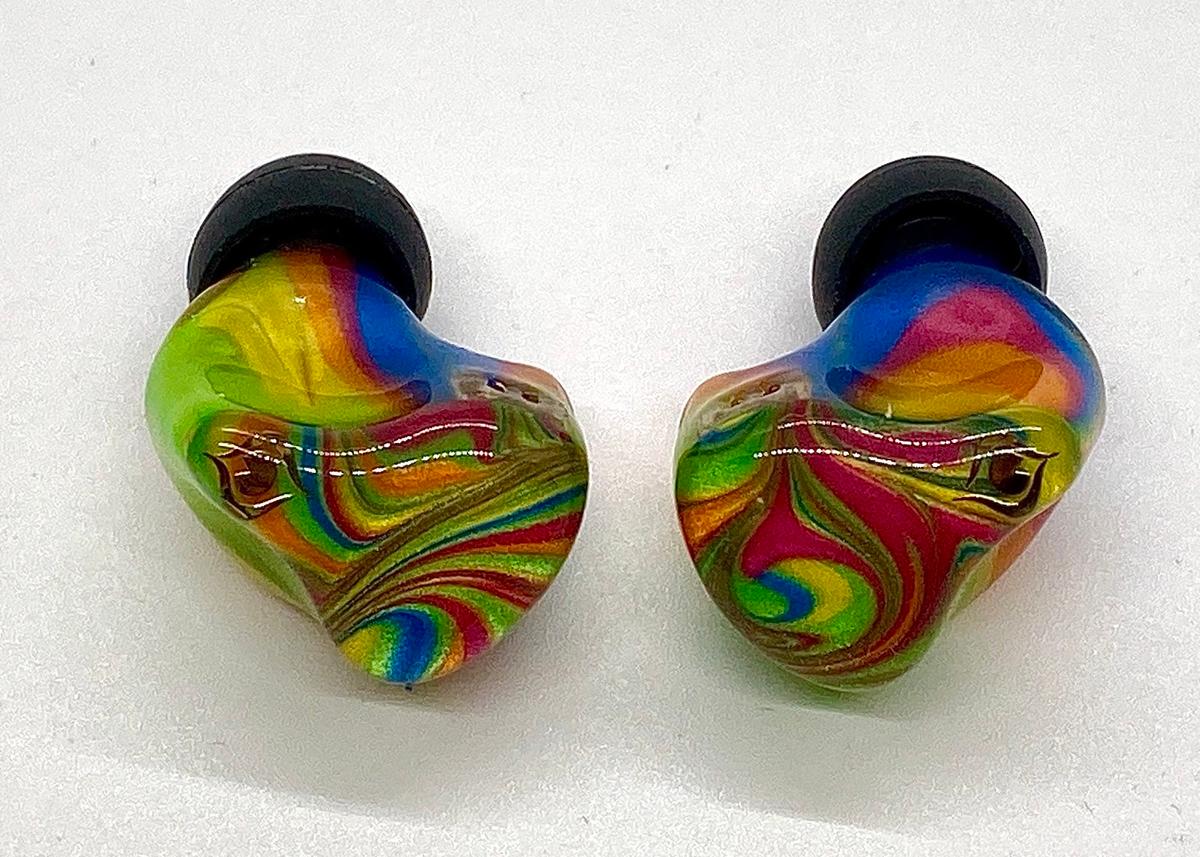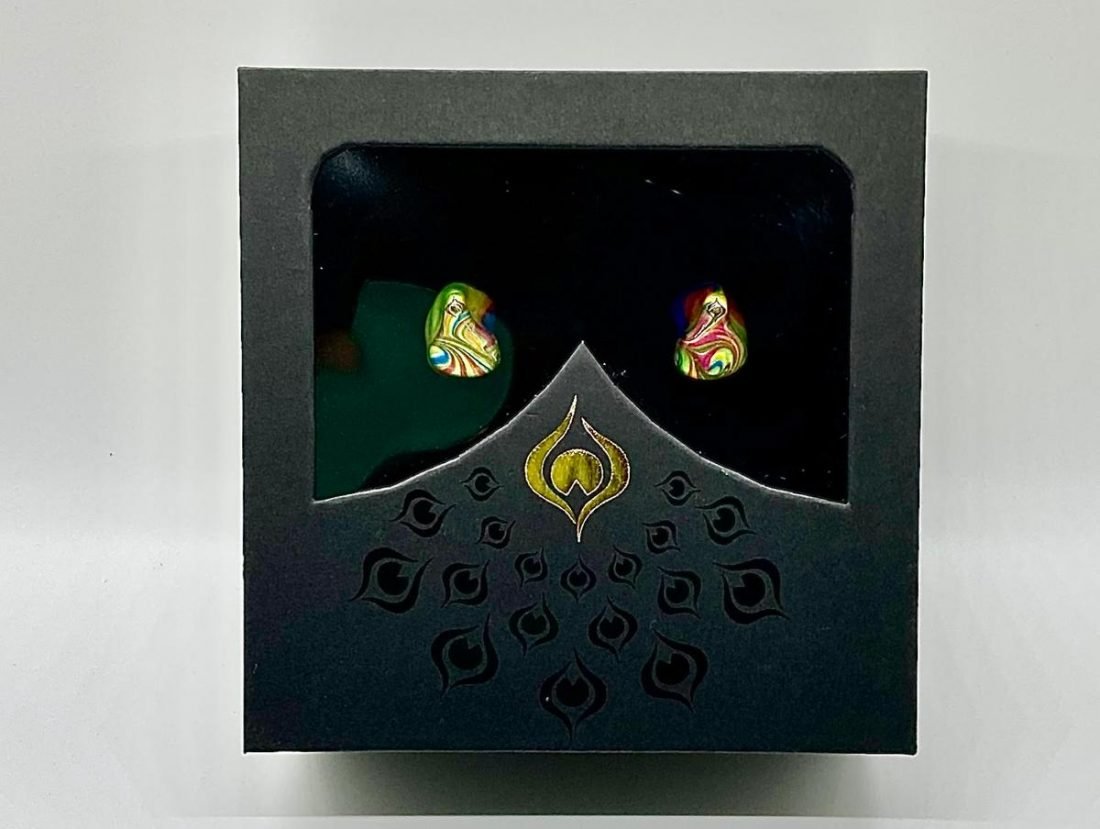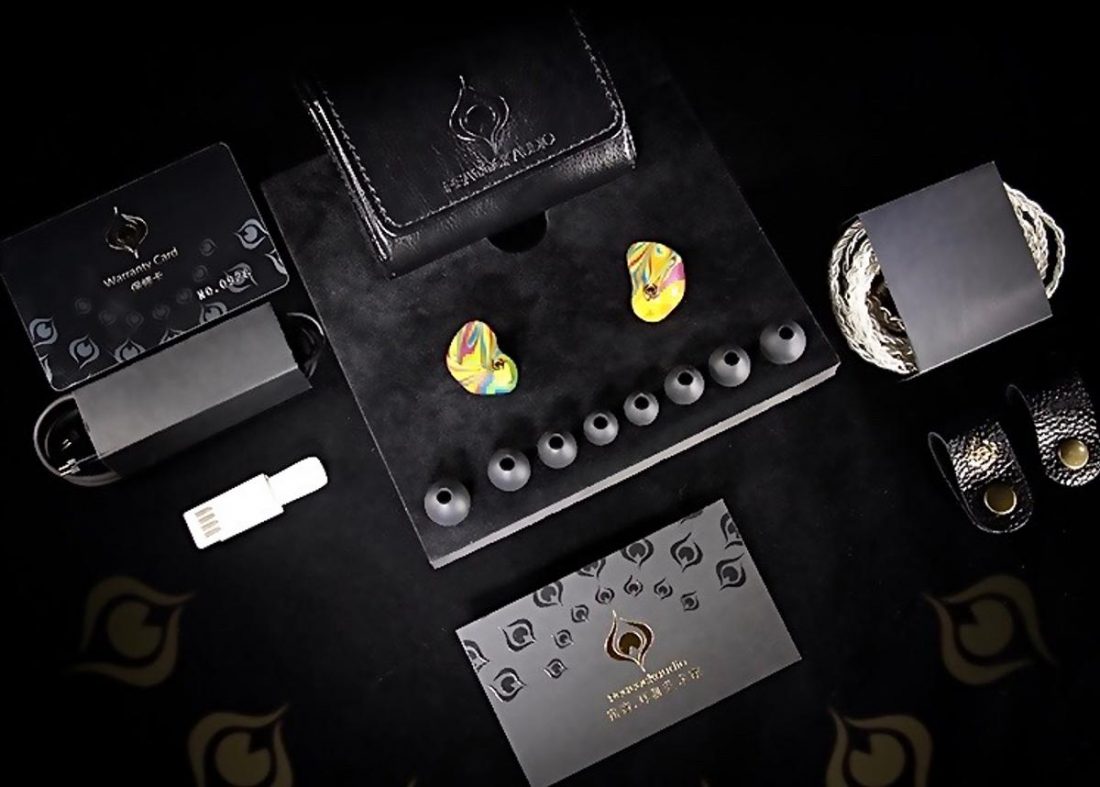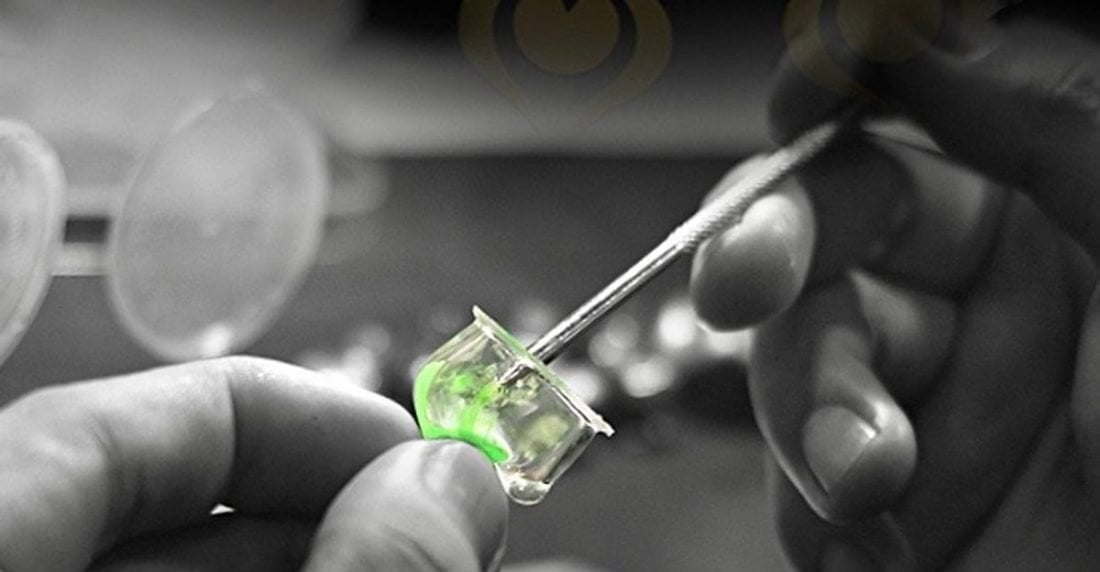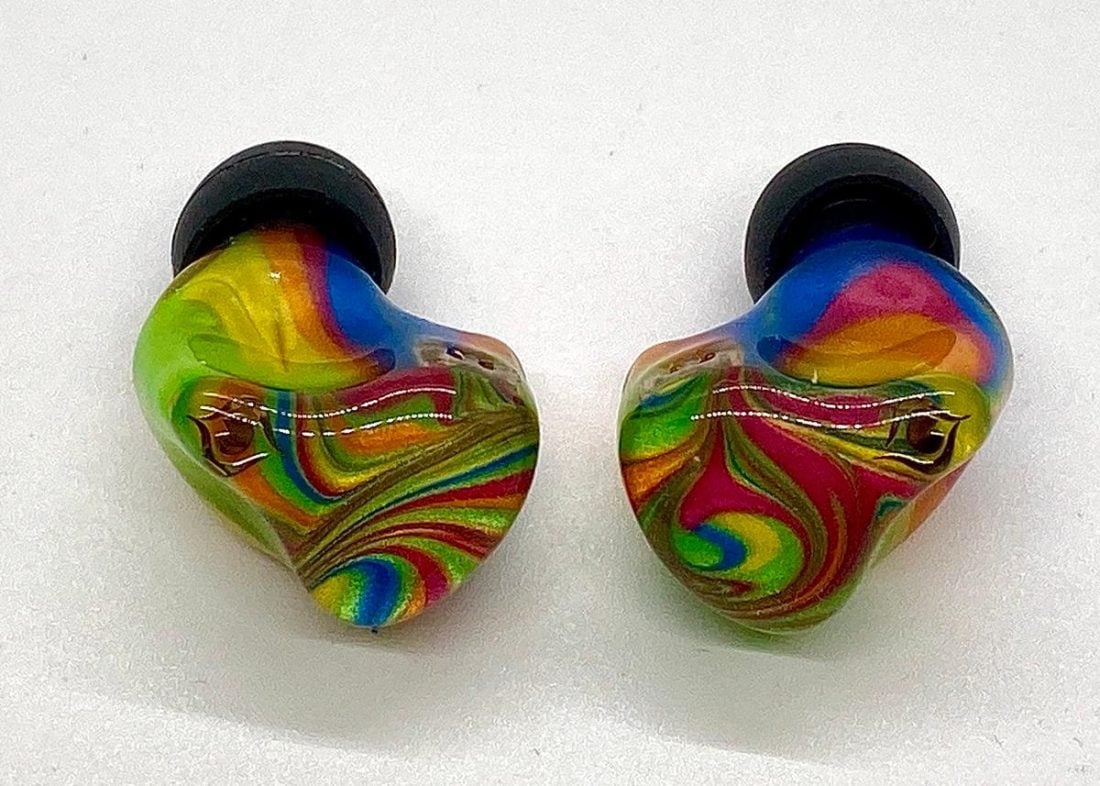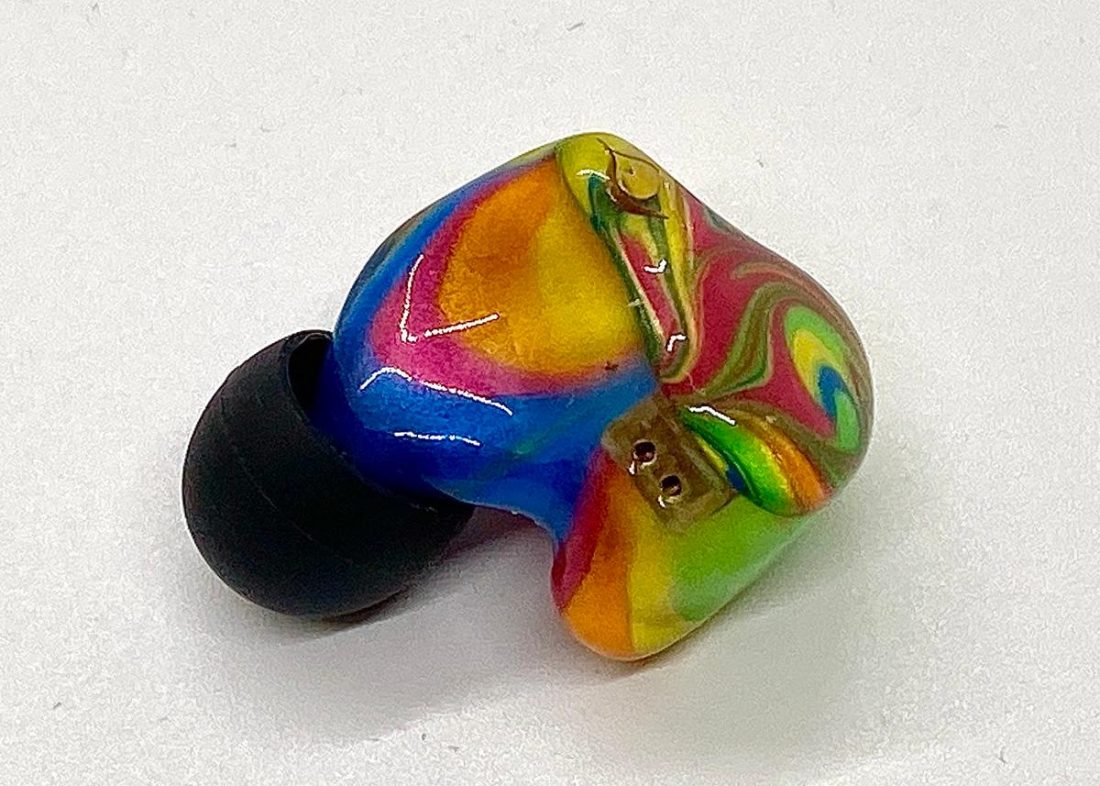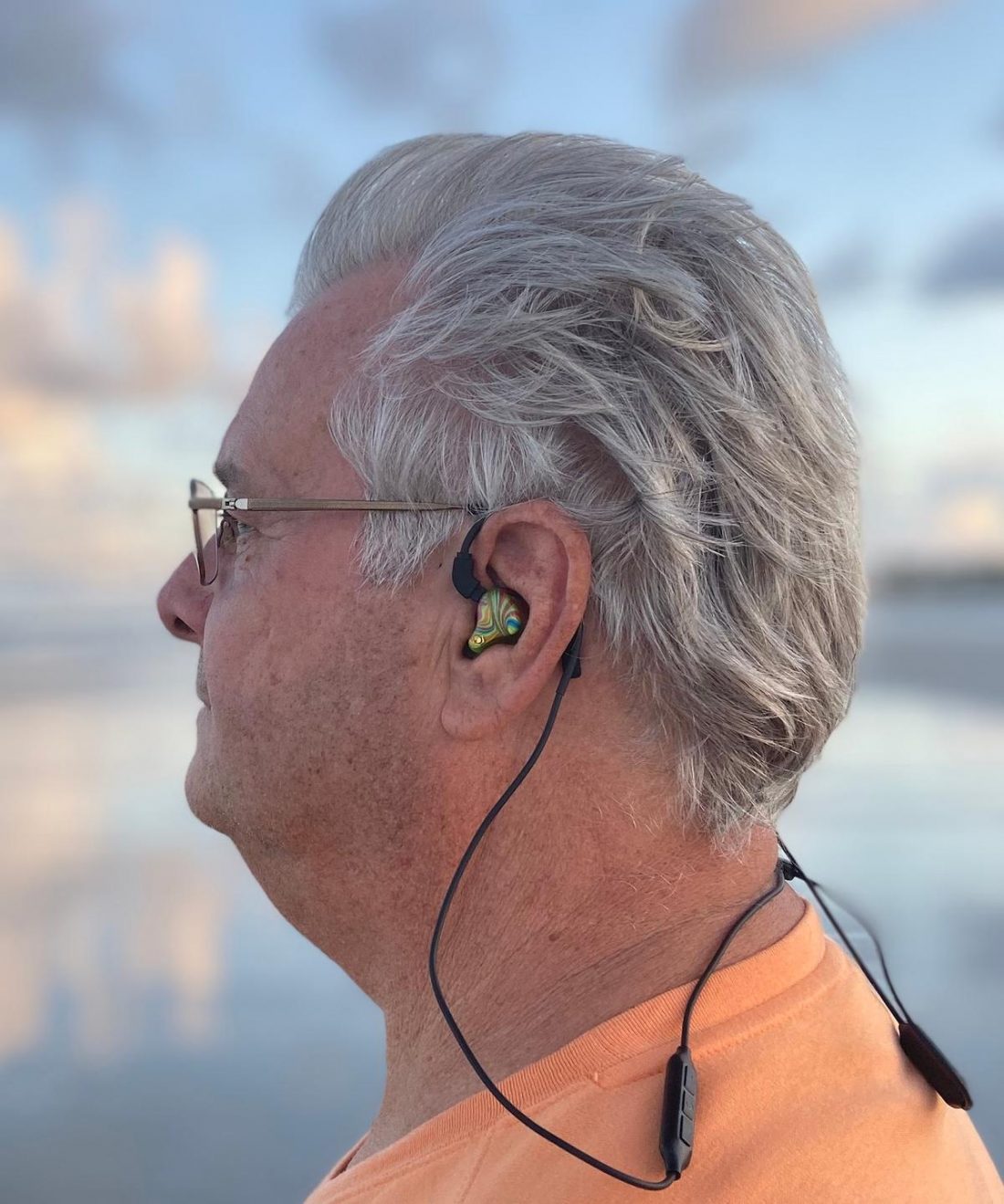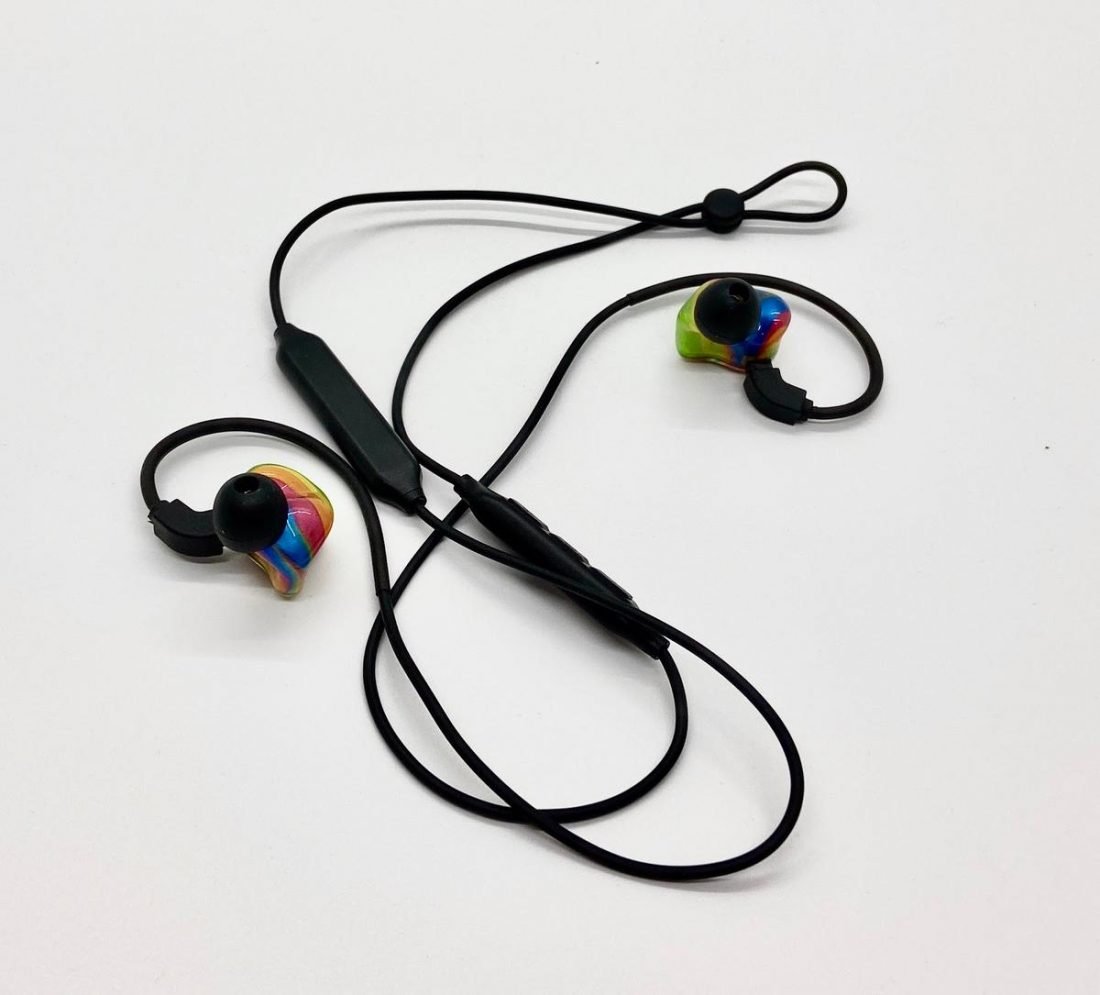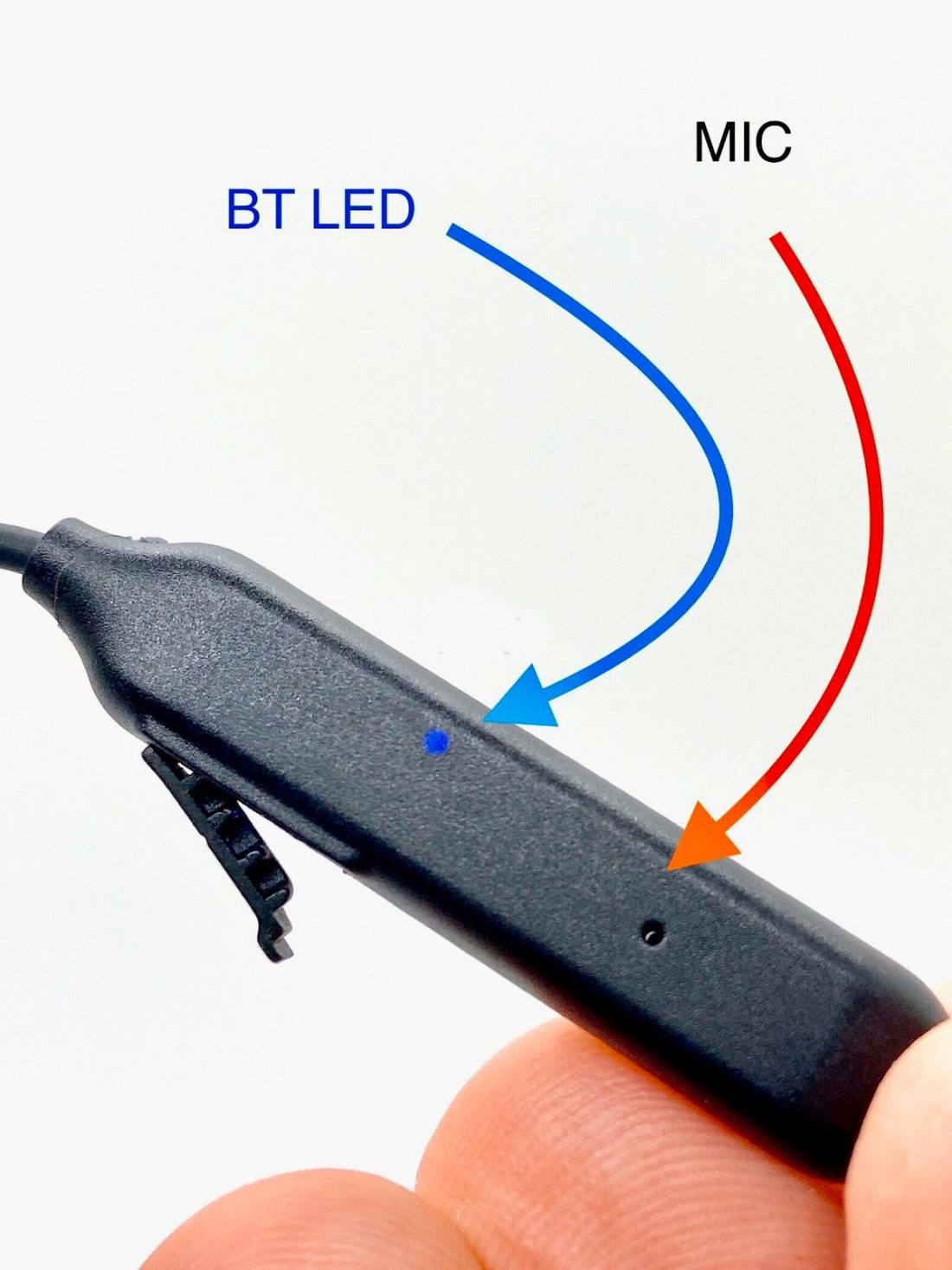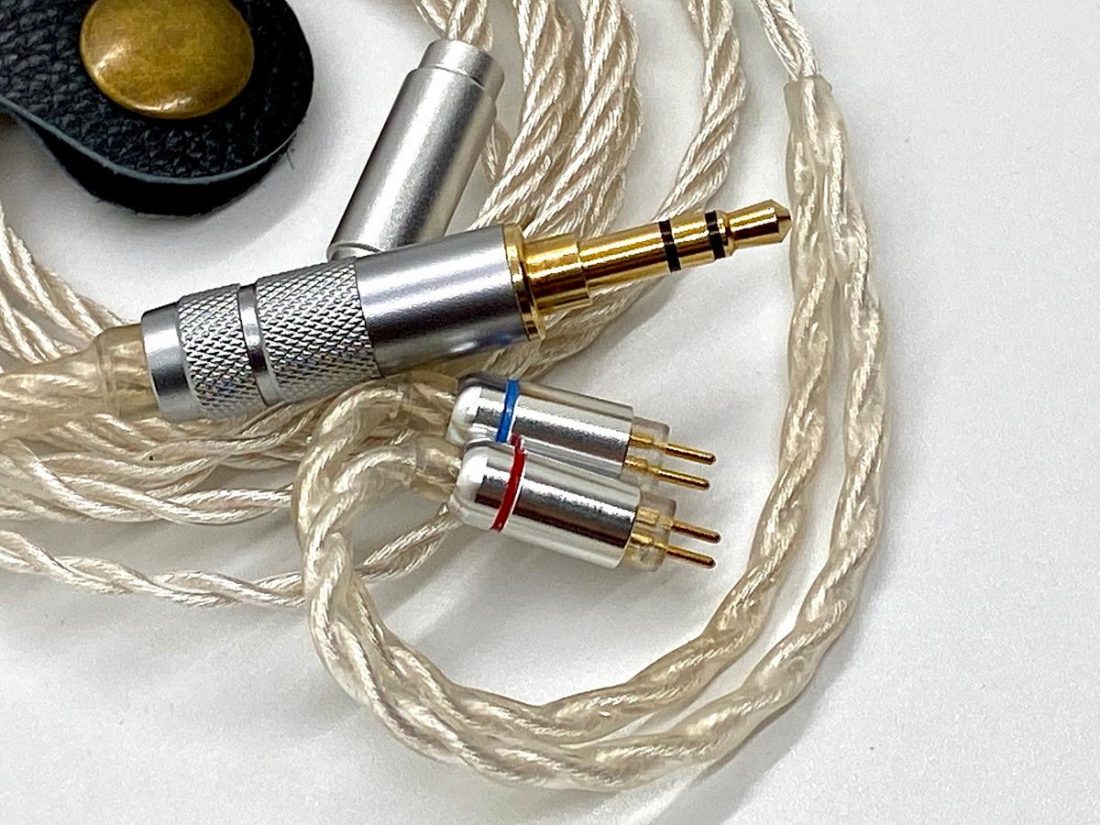The Peacock Audio P1 will appeal to most of the market in the ~USD$200 range who are looking for a unique visual presentation, good fit, sweatproof IPX6 rating, Bluetooth independence, and above-average sonic performance for general use.
Initial Impressions: Peacock Audio P1.
The packaging is impressive consisting of a high-quality black box which arrives in a sealed plastic bag. A clear window “presents” the key feature of the Peacock P1: It’s a unique hand-painted colorful and striking (rainbow in my case) appearance. As you unwrap your gift you see layers of components revealed and separated by black plastic sheets and notes in gold that make unpacking your P1s an experience. This takes the Asian tradition of gift wrapping to new highs! It also indicates a high degree of pride by the manufacturer! There are a few YouTube videos of unpacking if you wish to see the details and the best is this Youtube video by Prime Audio. So what’s in the box in unpacking order:
A pair of beautiful Peacock P1 IEMs (Rainbow in my case). Excellent imitation leather carrying case, felt-lined, magnetic latch. 2-pin Bluetooth (BT) 4.1 cable (maybe 5.0 depending on the supplier, see review) A USB cable for Bluetooth cable charging that is 2 inches and short but packs well in the case. 2 pin 3.5 mm connector cable almost 48 inches (120 cm) long. 2 snap (not magnetic) cable ties, cute but loose and non-captive, easy to lose. 4 Pairs of black silicone] ear-tips common to many other units…nothing special. Short but adequate English and Chinese user manual and Warranty Card.
If you do not like the rainbow pattern you see in the photos or prefer something more subdued you can choose from 10+ other designs. A good link to the optional pattern families can be found here.
Physical Qualities
Mechanical of P1 earbuds
The P1 IEMs are stunning in their appearance, both in the box and in the ear. They are fashionable and will surely invite comments. The unique look comes from being cast in Egger resin (same as that used for hearing aids) and then the INSIDE is hand-painted in many custom orderable designs. The result is a high-quality finish that is below the surface and away from wear. Every P1 is unique and no two are alike. I believe you could even polish them if they got scratched without affecting the design. This is the number one marketing point. Also, the fact that every single unit is “one of a kind”. There is a protective screen on the audio port to keep debris from getting inside and I suspect it would be easy to clean.
Fit and finish
My ear-buds look wonderful and have a great finish, as can be seen in the photo below: These are comfortable to wear and my ears did not fatigue. The resin and single 7mm micro driver make them very light. Their ergonomic design fits most ears and it fits my wife’s and mine even though we both have very different comfort levels with IEMs. The P1 works for both of us! As with most IEMs, the selection of the ear tip is critical to comfort sound performance. I found that these fit quickly and stayed in place walking and moving about without shifting…this is not the case with my other IEMs. They also did not require a lot of position tweaking to get their best sonic range. The cable routing and orientation are perfect as shown in the photo below: Connection is via two-pin style connector. It does not appear that the ear-buds have a rectangular receptacle area to assist in sealing out the environment. The BT cable and the 3.5mm cable do not offer any kind of seal either. I am not sure if there is internal sealing in the ear-buds to keep out sweat and moisture even though the BT cable is rated at sweatproof IPX6.
Bluetooth cable
This is a great feature and represents the second marketing reason for success. It is small and charges last about 8-10 hours. The fit is perfect except for the length which is a little short. Performance is excellent and I was able to receive solid connection even through 5 walls, 3 brick, and 2 wallboards at the same time! It is very directional as rotating at the challenging distance would cause a drop if my body was in the way. I found the low profile of the volume/feature to low for easy selection by touch only. The audio performance with the iPhone 11 is excellent with receiving parties reporting audio quality much better than using the iPhone’s built-in microphone. Talk time was about 2 hours of continuous talking before the 20% audio warning to recharge. This warning continues to repeat making an annoyance of itself. This means you will decide to recharge and frankly, that is about the best level for lithium battery life. There are two weaknesses. The charging port “door” is flimsy (see photo below) and seldom stays closed. I do not see how this can be IPX6 rated with this condition. The LED for BT connection is almost impossible to see nor is there any obvious place to look. It is possible to see it viewing inside the charging port. To help others I have taken a picture of it “ON” in the photo below: There is a short USB charging cable that is flat, clips folded, and can fit in the carry case that is well thought out. One thing that seems to be a confusion in other reviews and listings is the microphone. My unit has a microphone and functions fine with a phone just like other phone oriented accessories.
2-Pin cable
This seems well built and flexible. I like that it is smooth and slides well on clothing and skin. Connectors seem well made and reflect a good finish quality. 2-Pin at ear-buds is aluminum contributing to low weight. 3.5mm connector seems to be brass and stainless steel cover. Nice machine work and there is a machined extension that should clear most phone cases. Cord protection at each termination. 2-Pin connector prongs seem well made and well seated. My only concern is it appears the plating may wear easily on the pins. I noticed the wear after just two insertions and removal. The photo says it all:
What I would like to see physically different
Technical Specifications
Headphone type: Bluetooth + cable or BT cable included Drive unit: 7mm full frequency moving coil Sensitivity: ≥106dB Rated impedance: 16Ω Frequency response: 20-20kHz Wearing method: hanging ear Shell material: German egger resin
Cable:
Conductor material: 5N high purity copper silver alloy Number of cores: 4 single-strand 56-core hand-knitted Wire length: 1.2m ± 3cm Connection type: 3.5mm plug
Bluetooth headset cable parameters:
Bluetooth chip: CSR-8645 or QCC-3005 Bluetooth version: 4.1 or 5.0, depending on the version purchased Transmission distance: 10 meters barrier-free Battery capacity: 110mah Use time: 8-10 hours Waterproof rating: IPX6 (Sweatproof)
Sound Quality
Now we get to the most important reason someone buys IEMs. By definition: There are laboratory measurements that one can make of audio equipment and other reviewers have already performed such tests on this product. You can find a good, though very technical, review of these details here. Unfortunately, specifications and equipment test results only form a good basis for comparison and can explain some hearing test results but seldom can they substitute for a listener’s ears. Thus, we find ourselves depending on reviews, like this one, to help us make pre-purchase decisions.
Listening equipment and criteria
This review is targeted at what I believe is the market for these IEMs which is audiophile BT with phone capabilities. The sound portion of this review relies on the most commonly used source devices by this market and the media source. I did not use any special pre-conditioners, preamps, DACs, or high-performance comparison devices. For BT evaluation I used an iPhone 11 and also and iPhone 6+ to eliminate advances in the DAC performance in the 5-year development history. For the cable evaluation, I used only the iPhone 6+ since using the iPhone 11 required implementation of another DAC device to get the audio jack compromising results. For comparison to other IEMs, I used the Tin HiFi T3 purchased in August 2019. This has proven to be better (for my tastes) than any other IEMs I own and meets my listening criteria. For my source of media, I used Spotify set to “Very High” quality (320 kbits/sec) with no equalization or other settings in both Spotify settings and on the iPhone’s audio settings. The internet feed is 200+ Mbps. For listening tracks, I used mainly my favorite test tracks from:
Connection: With Bluetooth
I found there was no noticeable difference between the iPhone 11 and the iPhone 6+ using the BT cable which surprised me and I was unable to find any DAC specifications on either iPhone. I was pleasantly surprised by how good the BT performance was. The detail was present, including soundstage, clarity, and performance was very close to that of the cable connection. Amazing. The direct cable is superior from an audiophile perspective and results are in the next section. I could not compare results obviously with the Tin HiFi T3 as no BT capability and it would not make sense since comparison with direct cable would be adequate. Bottom line is that the BT connection option with the P1 is an excellent choice with very little sacrifice in audio performance except somewhat less in the bass range. I would not hesitate to use this when going mobile as it offers superior listening quality while providing excellent audio quality for phone service in both directions.
Connection: With cable
This device sounds good and has a comfortable quality to the sound. It flows and has sweetness. It has great clarity, detail, no trace of sibilance. If it is driven at high volume it begins to lose ground but that could just be the driving source. Note that I have read that a higher quality cable would yield even better results…something to try if you have one handy. Bass range No muddling and well balanced. These are not for Bass-heads. The bass is clear and punchy with accurate reproduction. It does not overpower and on pieces that are predominantly bass they shine with clear detail, sweet depth, and mild punch. These tend to soften high impact bass for example drum kicks. The 7mm seems to get the bass out and it is accurate. I like the bass performance and it suits my tastes. Middle range This is a range where I believe the P1 is weak. The middles are there and accurate but they disappear to the back of the sound stage and tend to be overpowered by the bass on one side and the treble on the other. They are not muddled but seem to play a secondary role. On pieces that are predominantly mid-range, they sound less real, lacking some clarity, detail, and especially punch. This seems to be mostly in the middle and not on mid-low or mid-high. On diverse music covering the full spectrum of sound, the mid-range issue seems not to play a role unless your mind is already expecting it from listening experience. Treble range This range is like the bass performance which surprises me as one would expect this area to be the weakest considering the emphasis is on bass performance and single-driver design. There are good soundstage and presence. Clarity and detail are good. What is missing is the detail on complex highs such as a brush on a snare drum…the hashy sound is there but not the detail of the sound of wires. Yeah, I know that sounds picky and imaginative but it is something that provides realism. Soundstage The P1 has a very wide soundstage. It really gives satisfaction from the dimension of the ambiance it creates and entertains you. It is one of the best I have heard. Most music I listen to tends to have bass leaning on the left and treble on the right. This mix suits the P1 perfectly. To be even more out there, I would say the soundstage is curved with the middle out deep in the back of the center.
Comparison with Tin T3
I choose to compare with the Tin HiFi T3 since I consider these a good audiophile standard in the low price range of USD$65. If you like detail, accuracy, a flatter range of linearity, crystal clear sound from bass to high then these make a good reference. They are for critical listening and not casual listening. They are heavy and do not allow a lot of movement. The Tin HiFi T3 is a reference that anyone can afford but keep in mind that bass is not as pronounced so using it for judgment in this range is limited. The P1 has deeper bass presence and really excels in that area by comparison. However, the T3 does seem to have clearer punch in that range. The T3 has a better mid-range and excels in its highs. I love the P1s for comfortable listening and general use. If I really want to analyze the sound or I am listening to less complex music then I would prefer the T3 for its soundstage that puts you right there…hearing the picks on the strings, the bow on the cello and the wires on the snare drum.
Conclusion
I believe you could not go wrong buying the Peacock Audio P1 because it provides such a pleasurable listening experience with accurate yet comfortable sound. It has a great soundstage and can be worn for hours without any fatigue, either sonically or physically. Add to this the great looks, quality, unique design, and excellent BT capability included and you have a winner.
